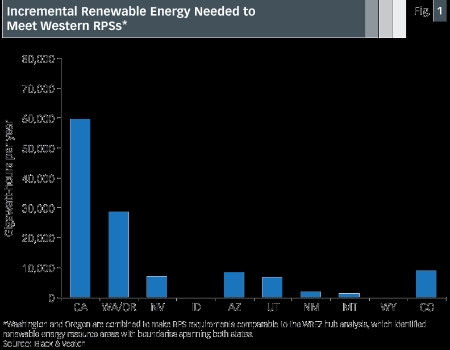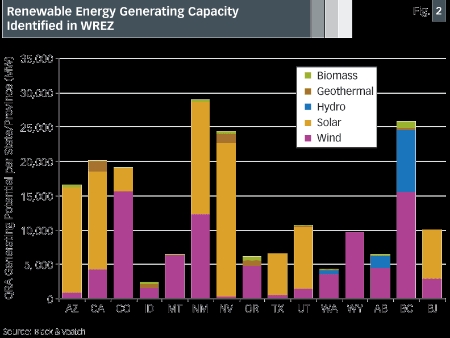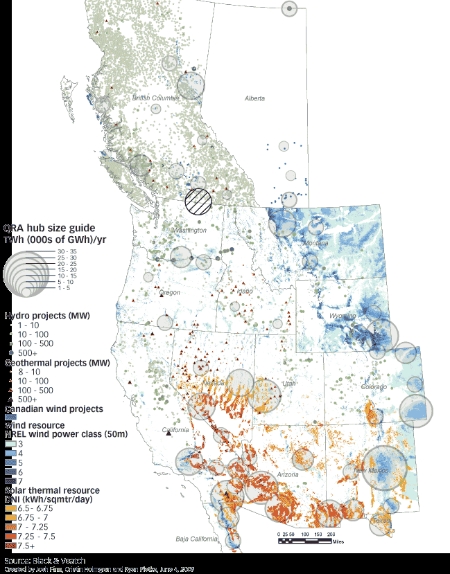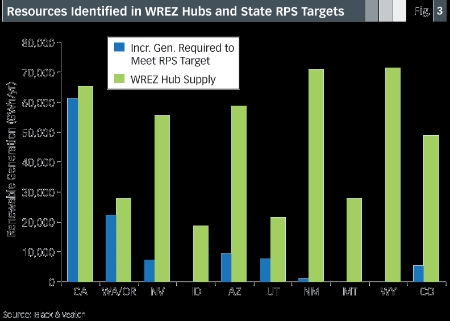Are Western RPS Standards Technically Feasible? Yes, but...
This article discusses renewable portfolio standards in the Western U.S. and compares the incremental generation required to meet them to the West’s developable renewable energy resources. The basis for this comparison is Phase 1 of the Western Renewable Energy Zones (WREZ) study recently published by the Western Governor’s Association. While WREZ is not a resource assessment, Phase 1 quantified the highest quality and densest developable renewable energy resource potential across the West. Comparing these resources to Western RPS requirements provides insight into the feasibility of meeting them and what barriers they face.
Rules vary across states and no two policies are exactly alike, but in general an RPS requires retail electricity suppliers to procure a certain minimum quantity of eligible renewable energy by a target date. This encourages renewable energy developers to provide competitively priced generation to utilities to meet their targets. Some utilities may also build or purchase generation projects to meet their RPS compliance goals. States often have interim targets that increase over time and must be met before their target dates. Retail suppliers typically must demonstrate compliance periodically. In almost every case, if the cost of meeting the RPS is “too high,” then utilities will not have to comply. This and other measures act as “safety valves” that keep costs down.
Among the 12 U.S. states in the Western Electricity Coordinating Council (WECC), 10 have RPSs (including the El Paso region of Texas, which is part of the WECC). Targets vary from 5 percent (in Texas) to 33 percent (in California) and target dates range from 2015 to 2025. RPSs are creating strong market demand for deploying renewable energy technologies. Based on Black & Veatch’s analysis, the amount of incremental renewable energy generation that must be added to meet WECC states’ RPS demands by their target dates is over 100,000 gigawatt-hours a year (GWh/yr). California’s requirement is the largest, requiring approximately 60,000 GWh/yr of incremental generation. If these goals are met with resources with an average of a 35 percent capacity factor, over 30,000 MW of new installed renewable energy generating capacity will need to be built in the next 15 years.

Whether or not these standards are achievable depends on a number of factors. These factors include the availability of renewable energy technologies in the marketplace and the capital to deploy them, the ability of developers and utilities to permit and successfully develop generating facilities, the availability and quality of developable resources and the transmission capacity to deliver them to load.
It is well known that the U.S. has enormous raw renewable energy resource potential. What is less well understood is how much of this resource could feasibly be developed given technical, land use and environmental constraints. What is the quality of these resources and where are the best ones located? The best resources might be located far from load centers. If this is the case, transmission will need to be developed, which will be difficult for a variety of reasons. These are important considerations for policymakers designing and implementing RPSs and for utilities complying with them. An assessment of the feasibly developable resource potential determines whether or not state-level RPSs are achievable from a technical perspective and provides insight into the issue of how they will be met.
Assessing WECC Renewable Resources
The Western Renewable Energy Zones project is a stakeholder-led initiative to prioritize areas of the WECC for transmission development to reach high quality renewable energy resources. Phase 1 was led by the Western Governors’ Association in collaboration with the U.S. departments of Energy, Interior and Agriculture, the Federal Energy Regulatory Commission, Canadian provincial premiers and a diverse group of stakeholders that included renewable energy developers, tribal interests, utility planners, environmental groups and government policymakers. The first phase was completed in June 2009. Its goal was to characterize the best developable renewable energy resources across the WECC and develop a transmission model to estimate the cost of delivering these resources to load. While the goal of WREZ is transmission planning, the results of Phase 1 provide insights into how much and where high quality renewable energy resources are located in the Western U.S., Western Canada and Baja California Norte, Mexico. More information about WREZ is available at the Western Governors’ Association’s web site: www.westgov.org/wga/initiatives/wrez/.
WREZ characterized biomass, geothermal, hydropower, solar photovoltaic, solar thermal and wind resources across the WECC states, Alberta and British Columbia and the portion of Baja California Norte located in the WECC. The areas of high quality, concentrated renewable resources identified in this phase of the project were called “qualified resource areas” or QRAs. These QRAs will be analyzed further for interstate transmission planning in future phases of WREZ and eventually will be called “renewable energy zones.”

QRAs do not represent all of the developable renewable energy resources across the WECC, but they contain the highest quality and greatest concentrations of these resources in each state. In some cases, they cover large portions of each state where renewable energy development is already occurring. While the QRA analysis is not a perfect assessment of developable renewable energy resources in each state, it provides an order of magnitude estimate and insight into the quality of developable renewable energy resources across states.
Concurrent with the QRA analysis, WREZ developed a screening tool to assess the cost of generating and transmitting resources from the QRAs to major WECC load centers. The WREZ Transmission Model enables users to select resources identified in QRAs and specify a transmission route to deliver those resources to a load center. Default cost and performance assumptions were developed, but users can also edit resource characteristics in the model.
WREZ sought not only to determine which resources are technically developable, but those that are most likely to be developed in each state and province. To do this, it was assumed that the highest quality resources would be developed first. The first step in the analysis was to eliminate from consideration each state’s lowest quality resources. This was done for wind and solar in the U.S. portion of the WECC based on National Renewable Energy Laboratory wind power class and solar insolation data. Biomass, geothermal and hydropower datasets used in WREZ also took into account these resource quality criteria. Based on the data, the best resources in each state were selected for inclusion in the analysis.
Once the lowest quality resources had been filtered out, areas where renewable energy could not be feasibly developed were excluded from the analysis. These included areas where development could not occur due to difficult terrain, existence of water bodies and urban areas and environmental restrictions. These areas were collectively called “exclusion areas.”
Even after taking into account all technical and environmental exclusions, it was reasonable to expect that not all of these renewable energy resources could actually be developed. In addition to the technical and environmental exclusions for which data were available, various constraints — such as land ownership, structures, local zoning restrictions or other factors — will prevent the development of even the most high quality renewable energy resources.
For this reason, wind and solar resource potentials were discounted to account for the likelihood that within any area only a portion of the total resource potential is developable. For wind, it was assumed that 25 percent of the screened area would be developable. This discount factor was based on industry experience and other regional wind studies. For solar, it was assumed that 3.5 percent of the land would be developable. Given the lack of industry experience and empirical data on the percentage of potential solar projects that are actually developed, this was chosen somewhat arbitrarily through stakeholder consensus. For biomass resources, it was assumed that only one-third of the resources available for power production could actually be used. Hydropower and geothermal datasets analyzed specific potential sites, so these resources were not discounted.
After filtering raw resource data for applicable exclusions and applying resource quality criteria and discounts, QRAs were identified using geographic information system software based on minimum and maximum size criteria. It was decided that QRAs should be large enough in terms of resource potential to justify a 500 kV transmission line, but small enough that resources could be collected and delivered to the transmission system at a low cost. It was determined that QRAs would generally be at a maximum 100 miles across and contain a minimum 1,500 MW of resource potential, the minimum generation required to justify a 500 kV transmission line.
A Plethora of Power
The WREZ study identified 53 QRAs consisting of over 200,000 MW of biomass, geothermal, hydroelectric, solar and wind resource potential across the West, which could theoretically generate over 500 terawatt hours of renewable energy per year. This is enough energy to satisfy all Western states’ RPS requirements nearly 5 times over. To put these estimates in perspective, the entire WECC peak load in summer 2007 was 150,000 MW and energy consumption was around 650 terawatt hours.
Resources were not distributed evenly across the WECC. Areas of the Southwest had the most abundant and highest quality solar resources. States on the eastern side of the WECC had the most significant and generally highest quality wind resources. Biomass resources were the greatest in areas with dense forests, such as the Pacific Northwest states and British Columbia. Hydropower resources made up a significant portion of British Columbia’s and Alberta’s QRA resource potential because it was determined hydropower was more likely to be developed in these provinces than in the U.S. Areas with the highest quality solar thermal resources were also the best areas for solar PV, so additional land was not identified for solar PV, even though it could be built practically anywhere.
A map (below) was produced as one of the outputs of Phase 1 of WREZ to display the raw renewable resources across the WECC after taking into account applicable exclusions, and the location and magnitude of the QRAs. The map represents resource concentrations that may be most cost-effective for regional transmission through the visual image of “hubs,” or general areas of high renewable resource concentration. Each hub is sized to represent the estimated amount of annual energy the area could potentially produce.

Each state and province involved in the WREZ initiative was given the chance to review and elect to remove or change the physical location of its hubs in advance of the hub map’s publication and inclusion in the WREZ Phase 1 report. This was done to allow states to remove hubs located in wildlife sensitivity areas that were not analyzed by the WREZ stakeholder group. Except when hubs were removed, changes did not alter the resources quantified in each area, just the specific location of each hub on the map.
Resources and Targets
WREZ identified more resources in each state than are required by each state’s RPS target. In places such as Colorado and New Mexico, WREZ identified many times the renewable energy resources required to meet each state’s RPS target. In other states, such as California and the Pacific Northwest states, slightly more renewable energy resources were identified than are required by RPS targets. The magnitude of resources quantified in each state does not imply quality; the project’s objective was to quantify the best resources in each state. As a result, while New Mexico has nearly as much potential identified as Wyoming, Wyoming’s potential is of a higher quality (and thus is, on average, cheaper to produce).

Only resources located inside WREZ QRAs were analyzed and are compared here. These include only some—albeit the highest quality and most concentrated—of the resources available in each state. Keep in mind that wind and solar resources are discounted significantly.
The highest quality renewable energy resources are often located far from the load centers. This is well known, yet WREZ confirms it and quantifies how much resource is located in various areas of the West. This is of particular interest to utilities that must find the lowest-cost generating resources to comply with their RPSs. It suggests they should consider resources far beyond their service territories and the states in which they operate. Indeed, many are already doing this. The extent to which utilities will actually buy power from far-flung generators will depend on many things, one of which will be the availability of transmission across state lines.
Barriers to Development
Although abundant developable renewable energy resources exist across the WECC, other issues will help determine whether or not RPSs are met. One is the cost of renewable energy resources. It has not yet been widely demonstrated that renewable energy is cost-competitive with conventional sources of generation. In almost every case where an RPS has been established, the rules provide that the standard need not be met if the cost is too high. If it is not possible to meet RPSs with renewable energy generated at an acceptable cost, these standards might not be met.
A second important issue, demonstrated by the results of WREZ Phase 1, is that the areas with high renewable energy demand often do not have the highest quality and most abundant renewable energy resources. This means accessing the lowest cost resources might require transporting them from one area to another, which requires transmission. There are a number of efforts under way to add transmission in the WECC to accommodate renewable energy, including WREZ. However, these initiatives began because coordinating, permitting and building interstate transmission has proven extremely difficult over the past few decades.
It is clear that enough developable renewable energy resources exist across the WECC to meet all state RPS goals with high quality renewable energy. The WREZ initiative provides important insights into where these are located and what they will cost. Whether or not the industry can scale up effectively to harness these resources will determine whether or not states will meet their goals.
Ryan J. Pletka is a project manager in Black & Veatch’s renewable energy group and directs work in the company’s San Francisco office focusing on assessments of advanced, distributed and renewable energy technologies. Mr. Pletka has participated in Black & Veatch assessments of more than 100 renewable energy projects and technologies since joining the company in 1998. He holds bachelor of science and master of science degrees din mechanical engineering from Iowa State University.
“Resources represented here reflect the best information on sensitive habitat available at the time the analysis was conducted. See (http://westgov.org/wga/initiatives/wrez/index.htm) for detailed information. Consult state wildlife agencies for current information.”
 To subscribe or visit go to:
http://www.renewableenergyaccess.com
To subscribe or visit go to:
http://www.renewableenergyaccess.com